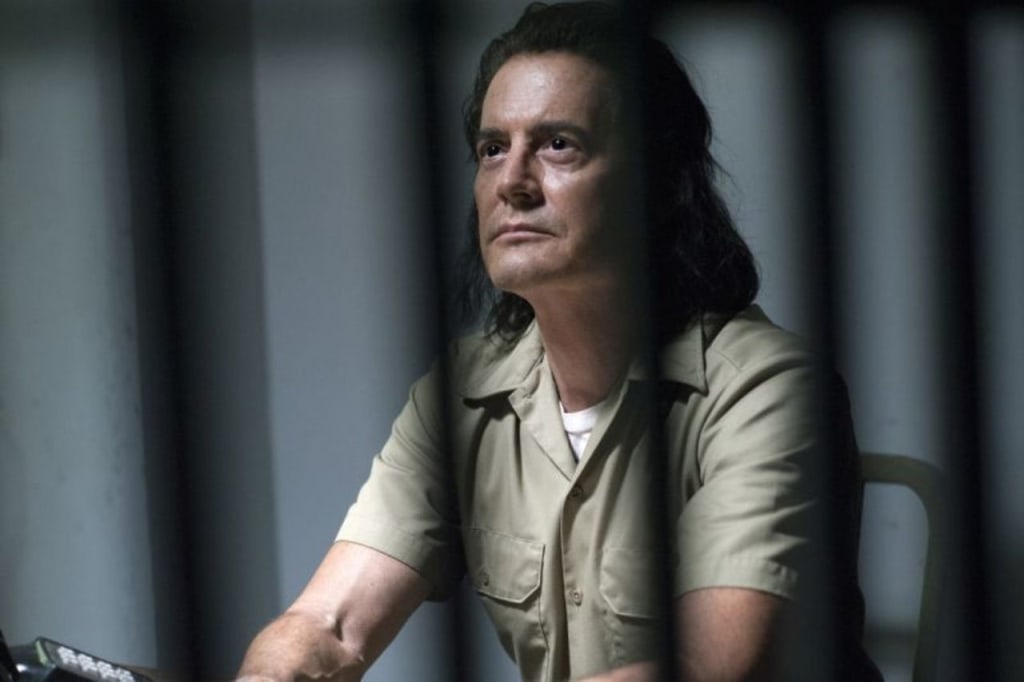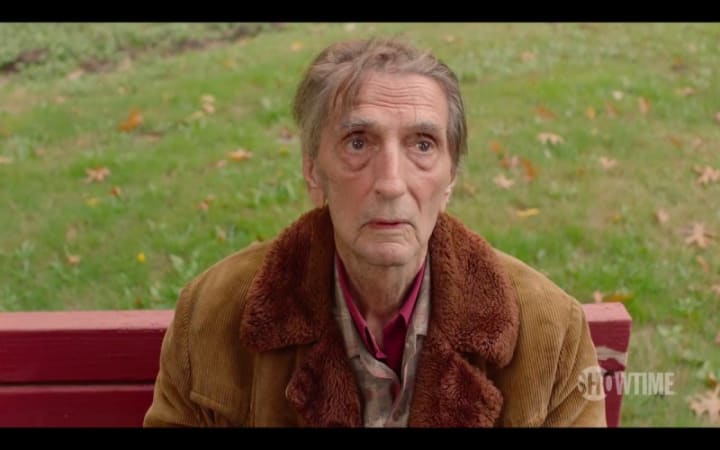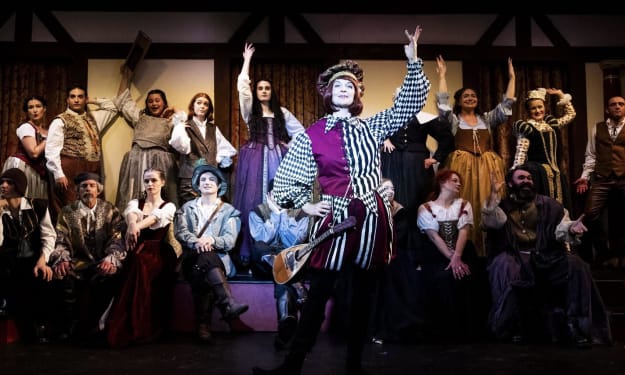Twin Peaks 2017: The Gifted and The Damned
Looking at some visually striking scenes from Parts 5&6 and what they say about the narrative.

Twin Peaks: The Return Parts 5&6, titled 'Case Files' and 'Don't Die' respectively, continue the trend of using a variety of digital techniques to enhance the visual storytelling; here I'll be taking a look at a few specific scenes and what they say about the world of Twin Peaks.
...The Gifted
I've talked previously about how it feels like Lynch & Frost are evoking a mood in The Return of magic realism - for those that haven't encountered the term before, the Oxford English Dictionary defines magic realism as:
"A literary or artistic genre in which realistic narrative and naturalistic technique are combined with surreal elements of dream or fantasy."
Oxford English Dictionary
This juxtaposition of the realistic and fantasy is apt, and reflective of the scenes I'll be talking about. First up, swaying distinctly towards the fantastical, are the scenes featuring Mr. C in prison from Part 5. While awaiting his phone call, Mr. C glances into his cell mirror and for the first time we see his reflection - before we can dwell on it, a smash cut to a prolonged take of Mr. C and BOB cackling like maniacs in the Black Lodge jolts like a sudden memory. When we cut back to Mr. C looking in the mirror, his reflection contorts into a hideous rictus grin, that of demonic entity BOB. Thanks to stock footage and some superb CGI, the sadly departed Frank Silva was able to appear on Twin Peaks again, allowing Lynch & Frost to respectfully work around the tragic loss of one of its most iconic actors while keeping his legacy going. With an impressive subtlety, they confirm what some had suspected since The Return launched; that Mr. C is not in fact Cooper possessed by BOB in the usual sense, but a separate entity inhabiting Cooper's body, connected to BOB in a symbiotic manner.
Later in the same episode, we see Mr. C make his phone call, in what amounts to the most palpable display of supernatural powers yet. After intimidating the guard with an (as yet) unexplained reference to a mysterious Mr. Strawberry, Mr. C says "I know who to call", before hitting a long sequence of numbers that creates an unusual tone; this in turn somehow causes all the prison's computer and alarm systems to go haywire. Layered sound design and strobe lighting effects create audio/visual pandemonium, with the guards freaked-out reactions and Mr. C's icy calm adding an underlying sense of dread. Freaked also seems the optimum word, with Mr. C's powers feeling like an unholy evolution of phone phreaking, a pre-internet technique of using specific audio frequencies to manipulate phone routing systems, and in many ways the progenitor of modern computer hacking; fittingly we've seen Mr. C use modern hacking techniques in episode 1&2, when after his phone call with 'Jeffries', he hacks into a US Military database. Could the association of the supernatural with electrical signals in Twin Peaks be an implication of the nature of Mr. C's abilities? A look at the Wikipedia definition of electrical signals tells us this:
"A signal as referred to in communication systems, signal processing, and electrical engineering is a function that conveys information about the behaviour or attributes of some phenomenon. In the physical world, any quantity exhibiting variation in time or variation in space is potentially a signal that might provide information on the status of a physical system, or convey a message between observers, among other possibilities."
Wikipedia
Maybe the dark empowered Mr. C has a kind of preternatural understanding of these electrical phenomena and this is what informs his new skills? Or maybe in 25 years he just learned how to be a damn fine (sorry...) hacker? Once the call connects, Mr. C drops one line - "The cow jumped over the moon" - before hanging up. Immediately afterwards another gorgeous drone-camera establishing shot takes us to Buenos Aries (famously where Phillip Jeffries was last seen..), before we see a poorly lit room, and a table with a wooden bowl, containing a small black box (another nod to phone phreaking?) of some kind; diodes blink twice before the box transmutes into...something small and black, possibly a lapel pin who knows. Much like the earlier scene with BOB's smile, the CGI is clean, delicate and strangely tangible. Unlike events in the Lodges, which are frequently an affront to physics, displays of magic in the physical world are more subtle; it is as though, when used in our reality, these powers have to at least pay lip service to the Laws of Nature.
...And the Damned

Harry Dean Stanton as Carl Rodd
The physical and spiritual worlds collide again in Part 6, and in heart-breaking fashion. Carl Rodd (played by Harry Dean Stanton), who we last saw running the Fat Trout Trailer Park in Deer Meadow, has upped sticks and settled back down in his home town of Twin Peaks. Rodd clearly still carries the weight of living, but seems less troubled than all those years ago in Deer Meadow - maybe the spirits have allowed him a period of rest. He heads into town with some friends, and seems to enjoy just watching contented lives go buy; he's clearly heartened by seeing a mother and her son at play. At the same time young wolf Richard Horne, high on some Chinese designer drug and feeling humiliated and intimidated by his meeting with off-kilter gangster Red, barrels back to town at high speed in a monstrous pick-up truck. Unwilling to wait behind a traffic queue at a pedestrian crossing, Horne hits the gas hard; in the same moment, the unaware driver at the front of the queue waves the mother and her son across the road. And before we have a chance to second guess the outcome, the unthinkable happens and Horne's truck plows through the child with devastating force.
The mother runs to her son's bloodied body, collapsing in grief and agony; Carl looks on in despair but sees what may be the boy's golden soul ascending sky-wards. As bystanders stand and stare in shock, their hearts breaking, Carl steps forward and attempts to comfort the mother, his touch and look offering her some solace; nearby an electrical pylon crackles and hums in a disquieting manor. Richard Horne meanwhile does not stop, and even attempts to clean his truck to hide the evidence...but he's been seen by witnesses and a day of reckoning will no doubt be coming for him.
So far there hasn't been a moment of emotional intensity this raw and affecting in The Return; it immediately draws comparison with the opening of the original Pilot, the uncontrollable heart-ache and despair of a parent losing their child laid bare, and the way that pain ripples out into a community. Here the community are bystanders, witnesses to an almost unspeakable daylight horror, as an ever increasing amount of people seem to be in our times; as a way of attempting to deal with so much suffering, some film or photograph what they see, adding a 'filter' to reality as a means to distance or detach themselves from it. This was touched on pertinently in 1999 movie The Blair Witch Project, the pioneer of found-footage films:
Josh Leonard: "I see why you like this video camera so much."Heather Donahue: "You do?"Josh Leonard: "It's not quite reality. It's like a totally filtered reality. It's like you can pretend everything's not quite the way it is."
The Blair Witch Project, 1999
It's something that could not be less true of the residents of Twin Peaks; in the aftermath of tragedy, not a single person is seen using a phone to record or photograph it. In Twin Peaks, grief and suffering is felt as keenly as it was 25 years ago at Laura Palmer's death; it is still a town where every life is valued, and where coming together in happiness and community means understanding they'll be there through the darkest times too.
This sequence is a masterclass in editing, cutting with increased fervency until the fatal moment, and then switching to long pans around the mother cradling her child's body, lingering shots of grieving on-lookers, and close ups of Carl Rodd's weathered and weary face; it's deeply affecting, a brutal run of the emotional gamut, from gut-wrenching shock to prolonged upset to other-worldly malaise. The unnervingly realistic effects used to create the impact are a stark contrast those we've seen so far, even during scenes of strong violence; Lynch & Frost do not want us escaping the actuality of this event. By comparison the CGI used to represent the boy's essence or soul feels ethereal; it's heavenly glow briefly seems to cause a look of hope to pass across Carl's face. Like The Log Lady and Sarah Palmer, Rodd seems blessed with an ability to observe other-worldly sensations but seems cursed to never fully understand them - The Gifted and The Damned indeed.
A third of the way into the Return and this scene may best encapsulate the new advances in visual effects and narrative drive, and how they compliment and enrich the essence of the original series. It thanks to digital effects and modern editing that it could come so vividly to life, and thanks to paid cable and it's lower restrictions that it could ever be shown on TV; but it's thanks to Lynch & Frost original creation of a show willing to explore all facets of life's duality, the sadness and joy, horror and beauty, sublime and absurd, and the way that spoke to the hearts of the viewers, that such a wildly imaginative and exciting piece of work could be made now.
About the Creator
James Giles
Writer, confessed geek and pop culture enthusiast, loves film, TV and video games. Blogged and written for various websites on all the above.
Enjoyed the story? Support the Creator.
Subscribe for free to receive all their stories in your feed. You could also pledge your support or give them a one-off tip, letting them know you appreciate their work.






Comments
There are no comments for this story
Be the first to respond and start the conversation.